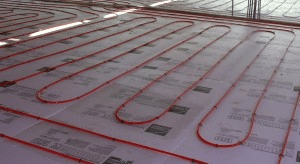In-Floor heating doesn’t have to be difficult or pricey. Floor heating is an efficient and practical way to heat your home. Radiant floor heat makes floors warm and comfortable to walk on. Install radiant floor heating in the bathroom and avoid the morning chill on your way to the shower.
Options include
- Electric radiant floor heating
- Hydronic radiant floor heating
- In-shower radiant floor heating
You can find many different brands of underfloor heating systems. This does not mean there are many different types of underfloor heating systems. Each brand may have slight differences in the way it’s manufactured, installed and operated, yet almost all underfloor heating systems belong to two broad types of underfloor heating: hydronic and electric. Difference between these systems in their usage: electric is more suitable in small areas such a bathroom or kitchen and has to be used with existing heating system; hydronic is price effective on large areas and can completely replace existing heating system.
Benefits
1. Even heat distribution
When you install a floor heating system to achieve a temperature of 25°C at floor level, this temperature will be the same throughout the room
2. Comfort
You can control temperature in every room of your house independently. Don’t worry about your kids playing on a cold floor. No more slippers and socks. No more discomfort from cold tile floors.
3. Safe
Once correctly installed, you can be sure an underfloor heating system is safer than other heating systems because there are no sharp surfaces or hot surfaces that may cause burns. The underfloor heating is specially attractive for families with young children.
5. Silent and clean
Underfloor heating doesn’t produce noise or dust like a fireplace or radiator.
6. Convenient
You don’t have to worry about furniture placement and seating arrangements with regard to the room’s heating system (radiators and window/wall ac systems can get in the way).
7. Dry
Floors dry faster after mopping, showering, spills, etc. This is especially handy in rooms such as bathrooms and kitchens.
8. Sustainable, economical and efficient

Under floor heating systems use water and electricity 20% – 50% more economically than other conventional heating installations. The concept of radiant floor heating dates back thousands of years, originated by the ancient Romans. This form of heating is much more efficient than forced-air systems because no energy is lost through ducts. Additionally, with no moving air, radiant heating can be beneficial for families suffering with indoor allergies. Modern radiant floor heating systems use liquid-based technology, in which warm water circulates through plastic tubing embedded in a floor slab or attached to the underside of sub-flooring. This method is extremely cost-efficient and eco-friendly, in that it requires little electricity to operate. The hydronic systems can also be heated using standard gas, oil or wood-fired boilers, solar water heaters, or any combination of these heat sources. Besides electricity savings and reduced flow of allergens, there are several more benefits to radiant floor heating. According to the Department of Energy, since these systems use much lower temperatures, boiler life can exceed 45 years.
Radiant heat transfer heats the objects in the room including the furniture and the person, not the air. This allows for a heating curve near the theoretical ideal and not a hot ceiling and a cold floor. Most radiant systems can also integrate the domestic hot water heating into the system and driveway melting system. Today this is the most efficient and comfortable heating system.



